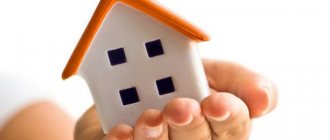Every owner, at least once in his life, has had the need to buy or sell real estate. In addition to specific designations, the advertisements indicate the cost of one square meter of the area being sold. It is very different, so you need to understand what it means and on what basis the area of the apartment is calculated. To clarify, you will need to learn to find differences in the terminology applied to the rooms in the apartment.
What it is
In various transactions, the areas of apartments are described as general, residential, auxiliary (utility). By “residential” we mean the space of rooms for various purposes, where people actually live. Auxiliary areas include areas for domestic purposes (kitchen areas, bathrooms, pantries, built-in cabinet sections). All areas of the apartment are taken as the area of the apartment, excluding the balcony, loggia, and veranda. Here it should be explained why these objects are not counted when adding up the meters of an apartment.
Hanging balcony structures, adjacent terraces and loggias in construction design documentation are classified as general types of premises; they are considered cold and are a general type of property, as are flights of stairs, landings, elevator cabins, and vestibules. In modern buildings in these areas, staircases are increasingly being added, running from the first to the last floor, especially in high-rise buildings. These structures are classified as emergency fire exits; they are prohibited from being dismantled and access to them is prohibited.
The concept of “total area of an apartment” is used in construction terminology and is used in the development of project documentation. It is needed to calculate square meters occupied by all areas of living space in the house. In this calculation, meters of balconies or loggias are added to the areas of apartments with a correction reduction factor of 0.3 and 0.5, respectively.
For terraces, a coefficient value of 1.0 is applied. This is done in order to add to the cost estimate for these areas, since building materials for them are required in smaller volumes than in the main areas. This formulation is also used in statistical departments that calculate the amount of housing stock under construction.
Sometimes there is confusion in the understanding of the term total living space.
In Art. No. 15 Residential Complex of the Russian Federation is all the meters of apartment space without balcony structures and loggias.
The instructions for accounting for housing stock say the same thing, but taking into account these areas.
In addition, the instructions contain the concept of “apartment area”, which has the same meaning as the term used in residential complexes – “total living space”.
In fact, in title documents, the total area of an apartment refers to the concept defined in the Housing Code of the Russian Federation.
The concept of the total area of the apartment
In accordance with Art. 16 Housing Code of the Russian Federation, an apartment is one of the types of residential premises. In order for a room to meet the requirements for an apartment, it must have the following characteristics:
- be separated from other premises;
- be in an apartment building (having more than two apartments);
- the premises must be provided with access to common areas in the house;
- consist of one or more rooms.
The apartment also includes auxiliary premises that ensure the livelihoods of the citizens living in it.
In accordance with Art. 15 of the Housing Code of the Russian Federation, the total area of housing is the sum of the areas of the entire residential premises. It also includes the area of utility rooms, which is necessary to meet the needs of citizens living in the apartment. The exceptions are loggias, balconies, terraces and verandas. Utility rooms include corridors, bathroom, toilet, storage room, built-in wardrobes, etc.
It is necessary to distinguish from the total area of housing the area that includes balconies, loggias, terraces, etc. The coefficients applied to them are:
- balconies, terraces - 0.3%;
- loggias - 0.5%;
- verandas and cold storage rooms - 1%.
Why are calculations needed?
On a regional scale, knowing the total area of the housing stock is necessary for statistical offices to assess their resource, to harmonize social norms, as well as to calculate tariffs for utility bills. In some types of provision of public utility services, the entire area of the apartment is the regulatory basis for calculating payment for:
- heating;
- overhaul;
- maintenance and current repairs of the common property of a residential building;
- removal and disposal of solid waste.
Also, based on the standard number of meters per resident, the size of the additional area is calculated for those who have the right to it. For example, military personnel and members of their families. In real estate transactions, the value of this parameter is the main criterion for calculating the cost of housing.
The provision of subsidies by the social service depends on how many meters the living space occupies; it is taken into account when establishing guardianship and when concluding transactions with various real estate.
When purchasing a home, you should carefully look at the ratio of residential and non-residential space.
This is necessary to determine the degree of comfort, since the rooms can be large, but the kitchen area and bathroom area can be tiny.
Differences between types of areas in an apartment
Expert opinion
Mironova Anna Sergeevna
Generalist lawyer. Specializes in family issues, civil, criminal and housing law
When calculating the area of an apartment, you should measure the rooms and living areas located in it. We will add up the results of measurements of rooms and areas that do not fall under the concept of living space area. These include kitchen departments, corridor areas, bathrooms, wardrobes in niches, pantries.
In two-level apartments, staircases and the area underneath them are considered similar zones; the area occupied by heating stoves or fireplaces that are used for heating is not considered.
Residential space is considered to be a separate space of dining rooms, children's rooms, bedrooms and living rooms, which is classified as real estate. They must meet sanitary standards and be suitable for permanent residence. Domestic areas are not included in the living area of the apartment, since it is not possible to live in them permanently.
The concepts of common and living areas of an apartment can be found in the instructions (clause 3.34; 3.35; 3.36; 3.37).
What does the area of the apartment affect?
The legislator distinguishes three types of residential premises:
The total area of the residential premises is used for the following purposes:
- heating fee ;
- calculating the homeowner’s share in the common property of an apartment building (the share is proportional to the size of the total area);
- calculation of the tax base when paying tax on land located in common shared ownership (proportional to the size of the total area);
- calculating the tax base when paying tax on residential premises and tax deduction for property tax for individuals;
- determining the cost of 1 m 2 of total area when transferring residential premises to citizens if their previous home is recognized as unsafe and included in the regional program for relocating citizens from unsafe housing stock;
- determining the standard for providing housing;
- determining the accounting standard for residential premises based on the size of which, the level of housing provision for citizens is determined;
- determining the size of housing space allocated under a social rental agreement or for ownership of various categories of persons (military personnel, disabled people, orphans, etc.);
- calculating the amount of gratuitous social payments for housing using federal budget funds.
At the moment, 28 constituent entities of the Russian Federation have switched to this order, including Moscow, Buryatia, Bashkortostan, Vladimir, Ivanovo regions, etc. In connection with this change in the procedure for calculating tax, the tax burden on citizens increases, so the legislator established deductions (tax-free areas) for residential properties in the amount of 20 m 2 of total area for an apartment, 10 m 2 for a room, 50 m 2 - for home.
This is important to know: Privatization of a summer cottage in a gardening partnership in 2021
Determining the size of living space is advisable for:
- determining the size of the sanitary standard for housing;
- provision of housing in a hostel (at least 6 m2 per person) (Article 105 of the Housing Code of the Russian Federation);
- housing assessments for concluding a real estate purchase and sale agreement;
- drawing up an act of inspection of the living conditions of a minor by the guardianship and trusteeship authorities;
- concluding a mortgage ;
- drawing up a transfer and acceptance certificate under contracts of sale, exchange, rent, social tenancy.
Determining the area of the premises is carried out for the purposes of:
- determining the size of housing owned by a citizen when providing him with an apartment under a social tenancy agreement;
- statistical accounting of the housing stock in the Russian Federation, calculating the amount of payment for housing and utilities, determining the social standard of housing and other purposes;
- calculating the cost of payment for general house needs;
- calculating the amount of subsidies for housing and utilities.
Thus, the three categories of residential premises are used for different purposes and it is important to determine when and which category is used in accordance with the legislation of the Russian Federation.
What is meant by usable area?
In transactions of purchase and sale of housing, the price per 1 sq. m appears.
m. Sellers, in most cases, voice this figure without specifying which meters are included in the calculation. Usually there is a share of slyness, and the price is based on the total square footage of the house along the outer perimeter. This is where the term “usable area” appears, which means the actual size of the interior of a residential building or apartment, with the exception of the footage of balconies and loggias. When calculating usable areas, the thickness of the walls is not taken into account. If you need to measure the useful meters of an apartment, then this is done on the inside of the walls, not including the thickness of the partitions, which occupy a significant proportion. If you calculate the size of the usable area, the price of one square meter of housing turns out to be higher than what sellers indicate.
Expert opinion
Mironova Anna Sergeevna
Generalist lawyer. Specializes in family issues, civil, criminal and housing law
If we consider a house made of brick and SIP panels as an example, then with the same perimeter, a house made of brick will contain approximately 30% less usable area than one made of panels, due to the difference in wall thickness.
How is the living area of an apartment calculated?
The living area of the premises is defined as the sum of the sizes of all living rooms. The registration certificate for real estate contains all the dimensional data of premises for various purposes. When purchasing real estate, it is enough to check the square footage of rooms and utility rooms. This is relevant if no redevelopment has been carried out.
Often, owners improve their living space to create more comfortable living conditions. By reducing the size of housing, built-in wardrobe structures are made or the spaces of rooms are combined. Widening doorways or installing arches is common.
You should carefully consider these facts when purchasing a home.
All these alterations fall under the concept of “reconstruction” and require permission to carry out the work.
If you have any doubts when purchasing, you can find out and calculate the living area of the apartment yourself. It is necessary to measure the square footage of the rooms along the inner perimeter of the walls and add them up - we get the desired value. Partitions that enter residential premises are not included in the calculation.
Calculating the living space of rooms of non-standard shape can be puzzling. In this case, we divide the entire perimeter of the room into familiar shapes: squares, rectangles, triangles. We find the arithmetic value of the area of each figure, sum them up and get the result.
If the room has a recess in the form of a niche, then, by law, it is included in the area of the living room if its height is more than two meters. The size of stoves and fireplaces is excluded from residential meters.
Formula applied
Let's look at the example of determining the living space of a standard three-room apartment with a balcony. Room sizes are 20, 18, and 15 square meters. m, kitchen – 9 sq. m, bathroom – 8 sq. m, toilet - 5 sq. m, corridor – 2.5 sq. m, balcony – 3 sq. m. Total amount (calculated without balcony):
20+18+15+9+8+5+2.5=77.5 sq. m.
Living area is: 20+18+15=53 sq. m.
Does a balcony or loggia count?
When calculating residential square meters of an apartment, the dimensions of balcony structures and loggias are not taken into account. However, if the redevelopment was carried out legally, and the copyright holder insulated and combined the balcony or loggia with the living room, then these meters will be added to the living area. In this case, the owner must have the appropriate document for the redevelopment and a registration certificate for the home ownership, prepared after the refurbishment, which indicates all the changes made.
If illegal redevelopment takes place in a real estate purchase and sale transaction, then it is better to refuse the purchase, since this housing cannot participate in mortgage lending, inheritance, or gift. When buying such an apartment, you should think about whether you need to buy so many problems with it. If you yourself are thinking about this issue, then do not remodel without obtaining permits.
How to officially make a payment
Calculation of housing sizes is carried out for a specific purpose:
- real estate transaction;
- calculation of the amount of building materials for construction or finishing;
- registration of ownership;
- production of technical passport:
- obtaining permission for reconstruction or redevelopment;
- rental.
Expert opinion
Mironova Anna Sergeevna
Generalist lawyer. Specializes in family issues, civil, criminal and housing law
In all cases, an error in calculations can play a cruel joke: there will not be enough building materials for repairs or construction, permission for alterations will be denied, or an inaccuracy will creep into the purchase and sale agreement, and the transaction may be declared invalid.
A safe and correct decision would be to contact a company licensed to carry out measurements. Such organizations have all the technical means to carry out accurate calculations and an appropriate set of instruments to perform these tasks.
When it is important to know the difference between the living area and the total area of the apartment
- When choosing real estate, it is important to remember that balconies or loggias are not included in the total area of the property . When purchasing an apartment, it is worth checking whether the owner (the development company) included them in the overall square footage of the apartment. This is important, since the total area of all premises affects the market value. Sometimes the footage of a balcony or loggia can be taken into account, but then this must be done with a reduced coefficient.
- The living area is always less than the total area , with the exception of the case discussed above, therefore, even if two apartments have the same total square footage, one apartment may seem smaller than the other due to the smaller area of the living rooms.
- It is important to know that fees for housing maintenance and major repairs, as well as utility bills (in the absence of an individual meter), directly depend on the total living space . Property tax and rental fees are also calculated.
- The size of the living space is the main indicator for determining the degree of need of a family to improve living conditions. Also, this indicator will play a decisive role when allocating housing to a family under a social lease agreement or allocating funds for its purchase under government social programs, for example, for young families, orphans and military personnel.
- In an apartment building, the common property is divided between the apartment owners, also based on the total square footage of the occupied apartments. And this share, in turn, is decisive in the distribution of the number of votes at the general meeting of owners in apartment buildings. That is, the more squares there are in the property, the greater the role the owner plays in resolving general house issues.
This is important to know: Criminalization of property relations in the process of privatization
There are many situations in life when knowing which concept is used and when can be useful. Awareness of this issue will help in real estate transactions or in monitoring the correct calculation of utility bills and determining social norms, which can greatly make life easier and save the family budget.
Calculations for a private house
When determining the size of living space in a private household, the calculation principle is no different.
To determine it, you need to measure the entire living space where there is heating and add up the result. The entire area of the household will consist of the sum of residential and living areas (bathroom, kitchen area, storage room, niches, veranda). To find the number of square meters under the building, measurements are taken of the external walls of the house along the perimeter. If there is a need to calculate finishing materials, facade measurements of the walls of the house are performed along the base and cornice. The resulting number is multiplied by the height of all walls, and the desired value is found.
All characteristics of a private household are taken into account in the cadastral passport. It contains information about the location, data on internal and external measurements, purpose of the building, year of commissioning, cadastral number of the land plot, inventory value. There is also a construction plan and a description of the facility.









